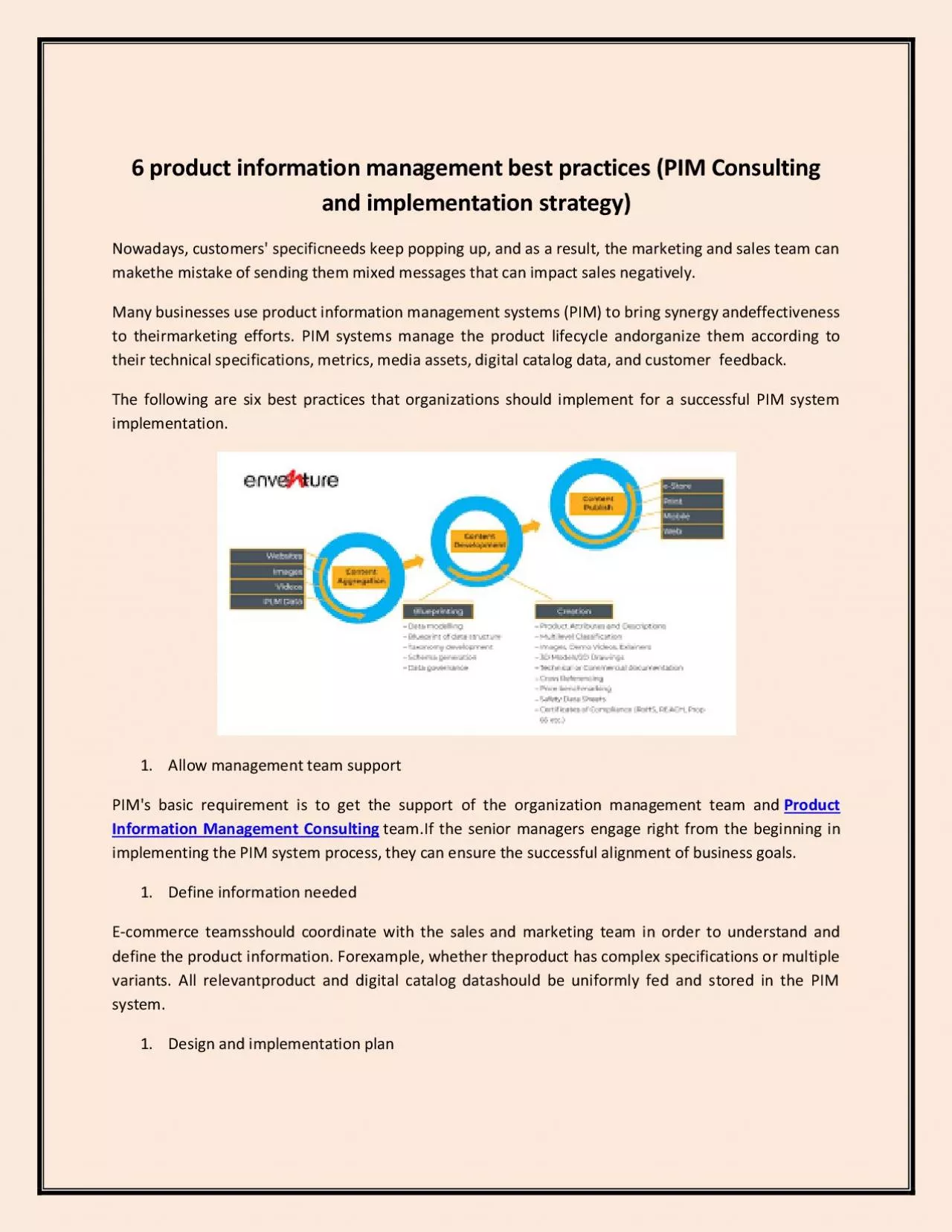/


Nowadays customers specificneeds keep popping up and as a result the marketing and sales team can makethe ID: 963683
Download Pdf The PPT/PDF document "6 product information management best pr..." is the property of its rightful owner. Permission is granted to download and print the materials on this web site for personal, non-commercial use only, and to display it on your personal computer provided you do not modify the materials and that you retain all copyright notices contained in the materials. By downloading content from our website, you accept the terms of this agreement.
6 product information management best practices (PIM Consulting and implementation strategy) Nowadays, customers' specificneeds keep popping up, and as a result, the marketing and sales team can makethe mistake of sending them mixed messages that can impact sales negatively. Many businesses use product information management systems (PIM) to bring synergy andeffectiveness to theirmarketing efforts. PIM systems manage the product lifecycle andorganize the m according to their technical specifications, metrics, media assets, digital catalog data, and customer feedback. The following are six best practices that organizations should implement for a successful PIM system implementation. 1. Allow management team support PIM's basic requirement is to get the support of the organization management team and Product Information Management Consulting team.If the senior managers engage right from the beginning in implementing the PIM system process, they can ensure the successful alignment of business goals. 1. Define information needed E - commerce teamsshould coordinate with the sales and marketing team in order to understand and define the produ ct information. Forexample, whether theproduct has complex specifications or multiple variants. All relevantproduct and digital catalog datashould be uniformly fed and stored in the PIM system. 1. Design and implementation plan For a successful PIM implemen tation, the e - commerce team should take the help of the sales and marketing team internally and productimplementation partners to design the required PIM system and ensure itmeets theorganization's objectives. 1. Selecting the right software There are dozens of readily available PIM systems in the market. Each one of them has their strength and weaknesses. Some PIM systems prioritize data syndication features that allow external applications to receive product information. Others allow product comparison on th eir Company's website. After defining the information requirement, the PIM Solutions team should compare which system meets the organization's needs the most. 1. Encourage empl oyee engagement The sales and marketing team needs to adopt the PIM system; otherwise, it will not be effective. Business leaders will get fragmented feedback from the e - commerce platform and sales channels. During the early stages of PIM implementation , the e - commerce leaders should collect feedback from their sales and marketing colleagues and what the team wants in the PIM system. The team can incorporate the important elements into the system, considering the budget and timeline. Also, a training pr ogram can be organized after the PIM launch for the employees. Additionally, an incentive program will motivate the employees to use and support the system's adoption. Business leaders should treat the PIM system as a product that it should market effectiv ely to its marketing and sales team. 1. Take feedback for improving the system For a PIM system to remain a single and authentic point for product data, it should continuously be fine - tuned based on sales and marketing feedback. After the PIM system is implemented, users polling should be done to understand whether the system is work ing and up to the mark. Regular feedback and fixing the system helps to live up to the teams' expectations and make the PIM data robust and helpful for driving the Company's sales. Conclusion A PIM system is a significant investment for an organization in terms of time, resources, and money. For it to be successful, the senior management and PIM Services should ensure how data control, consistency, and validity can help to make the sale team more effective.